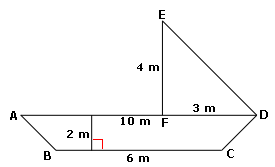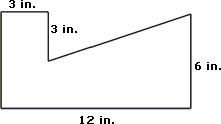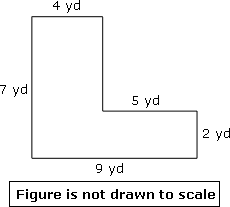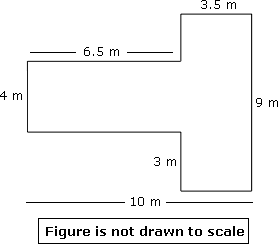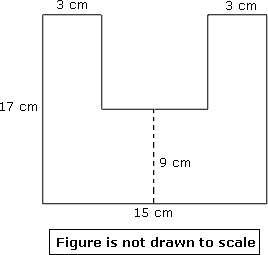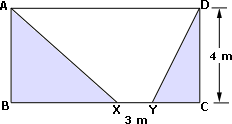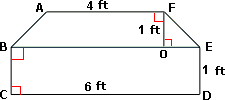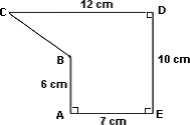Solved Examples and Worksheet for Perimeter and Area of Composite Figures
Step: 1
The area of the figure = Area of the trapezoid ABCD + Area of the Δ DEF.
Step: 2
The area of the trapezoid ABCD = 1 2
Step: 3
= 1 2
Step: 4
= 1 2
[Substitute AD = 10 m, BC = 6 m and height = 2 m.]
Step: 5
= 1 2
[Simplify.]
Step: 6
= 16 m2
[Simplify.]
Step: 7
The area of ΔDEF= 1 2 1 2
Step: 8
= 1 2
[Substitute FD = 3 m and EF = 4 m.]
Step: 9
= 12 2
[Simplify.]
Step: 10
So, area of the figure = 16 + 6 = 22 m2
[Substitute the values.]
Correct Answer is : 22 m2
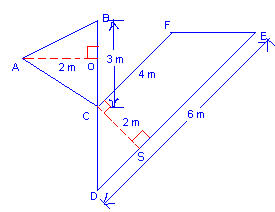
A. 5 m2
B. 12 m2
C. 13 m2
D. None of the above
Step: 1
The total area of the figure = area of the triangle ABC + area of the trapezoid CDEF.
Step: 2
The area of the triangle ABC = 1 2
Step: 3
= (1 2
Step: 4
= (1 2
[Substitute BC = 3 m and AO = 2 m.]
Step: 5
= 3 m 2
[Simplify.]
Step: 6
The area of the trapezoid CDEF = (1 2
Step: 7
= (1 2
Step: 8
= (1 2
[Substitute CS = 2, CF = 4 and DE = 6.]
Step: 9
= (1 2
[Work inside the grouping symbols.]
Step: 10
= 10 m2
[Simplify.]
Step: 11
The total area of the figure = 3 + 10 = 13 m2.
[Substitute the values.]
Correct Answer is : 13 m2
Step: 1
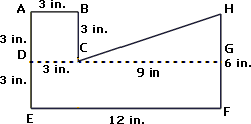
Step: 2
Area of the figure = area of square ABCD + area of rectangle DEFG + area of triangle CGH
Step: 3
= AB × AB + DE × EF + 1 2
Step: 4
= 3 × 3 + 3 × 12 + 1 2
Step: 5
= 9 + 36 + 13.5
Step: 6
= 58.5 in2
Correct Answer is : 72 in2

A. 160 in.2
B. 180 in.2
C. 80 in.2
D. 84 in.2
Step: 1
The area of the figure = Area of the trapezoid ABCD + Area of the Δ DEF.
Step: 2
The area of the trapezoid ABCD = 1 2
Step: 3
= 1 2
Step: 4
= 1 2
[Substitute AD = 16 in., BC = 12 in. and height = 4 in..]
Step: 5
= 1 2
[Simplify.]
Step: 6
The area of ΔDEF = 1 2 1 2
Step: 7
= 1 2
[Substitute FD = 6 in. and EF = 8 in..]
Step: 8
= 48 2
[Simplify.]
Step: 9
So, area of the figure = 24 + 56 = 80 in.2
[Substitute the values.]
Correct Answer is : 80 in.2
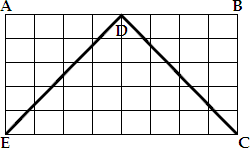
A. 40 cm2
B. 60 cm2
C. 20 cm2
D. 80 cm2
Step: 1
In the given figure, the area of ABCE is 40 cm2 and the area of ECD is 20 cm2.
[Given.]
Step: 2
The area of ABCDE = area of ABCE - area of ECD
[From the given figure.]
Step: 3
= 40 - 20
[From step 1.]
Step: 4
= 20
[Subtract.]
Step: 5
Therefore, the area of the given figure ABCDE is 20 cm2 .
Correct Answer is : 20 cm2
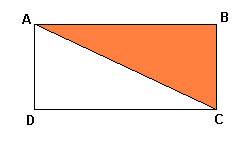
A. 24 cm.2
B. 28 cm.2
C. 12 cm.2
D. 16 cm.2
Step: 1
Diagonal AC divides the rectangle into two congruent triangles.
Step: 2
Area of the triangle ABC = 12 cm2.
Step: 3
Area of the rectangle ABCD = 2 × area of traingle ABC.
= 2 × 12
Step: 4
So, the area of the rectangle ABCD = 24 cm2.
Correct Answer is : 24 cm.2

A. 56 square units
B. 48 square units
C. 44 square units
D. 52 square units
Step: 1
In the given figure, 52 squares are colored.
Step: 2
Area of each square = 1 square unit.
Step: 3
Area of 52 squares = 52 × 1 = 52 square units.
Correct Answer is : 52 square units
Step: 1
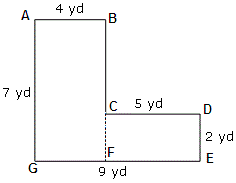
Step: 2
From the figure, Area of the rectangle ABFG = length × width = AG × AB = 7 × 4 = 28 sq.yd
Step: 3
Area of the rectangle CDEF = length × width = CD × DE = 5 × 2 = 10 sq.yd
Step: 4
Total area of the figure ABCDEFG = area of the rectangle ABFG + area of the rectangle CDEF
Step: 5
= 28 + 10 = 38
Step: 6
So, total area = 38 sq.yd
Correct Answer is : 38 yd2
Step: 1
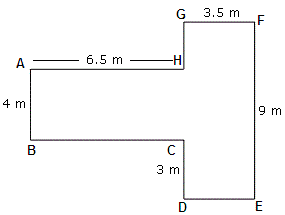
Step: 2
From the figure, AB = 4 m., BC = 6.5 m., CD = 3 m., DE = 3.5 m., EF = 9 m., FG = 3.5 m, GH = 2 m, HA = 6.5 m.
[GH = FE - (CD + AB).]
Step: 3
Perimeter of the figure = Sum of all the sides of the figure.
[Formula.]
Step: 4
Perimeter of the figure = AB + BC + CD + DE + EF + FG + GH + HA
Step: 5
4 + 6.5 + 3 + 3.5 + 9 + 3.5 + 2 + 6.5 = 38
[Substitute the values and add.]
Step: 6
Perimeter of the figure = 38 m.
Correct Answer is : 38 m
Step: 1

Step: 2
From the figure, AB = 17 m, BC = 15 m, CD = 17 m, DE = 3 m, EF = 8 m, FG = 9 m, GH = 8 m, HA = 3 m
Step: 3
Perimeter of the figure = Sum of all the sides of the figure.
[Formula.]
Step: 4
Perimeter of the figure = AB + BC + CD + DE + EF + FG + GH + HA
Step: 5
17 + 15 + 17 + 3 + 8 + 9 + 8 + 3 = 80 m
[Substitute the values and add.]
Step: 6
Perimeter of the figure = 80 m.
Correct Answer is : 80 cm
Step: 1
Label the given figure as shown below and draw line EH perpendicular to DF.
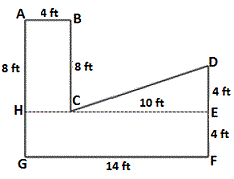

Step: 2
Area of rectangle ABCH = 8 × 4 = 32 sq ft.
[Area of rectangle = length × width.]
Step: 3
Area of triangle CDE = 1 2
[Area of triangle = 1 2
Step: 4
Area of rectangle EFGH = 14 × 4 = 56 sq ft.
[Area of rectangle = length × width.]
Step: 5
The total area of the given figure ABCDEFGH = Area of rectangle ABCH + Area of triangle CDE + Area of rectangle EFGH.
Step: 6
= 32 + 20 + 56
[From steps 2, 3, and 4.]
Step: 7
= 108
[Add.]
Step: 8
Therefore, the total area of the given figure is 108 sq ft.
Correct Answer is : 108 sq ft
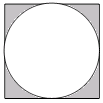
A. 47.4 cm
B. 50.4 cm2
C. 49.4 cm2
D. 48.4 cm2
Step: 1
From the figure, diameter of the circle = side of the square = 15 cm.
Step: 2
Area of the circle = π d 2
[Radius = diameter 2
Step: 3
= 3.14 x (15 2
[Substitute the values.]
Step: 4
= 3.14 x (7.5)2
[Divide 15 by 2.]
Step: 5
= 3.14 x 7.5 x 7.5
Step: 6
= 176.63
[Multiply.]
Step: 7
Area of the circle = 176.63 = 176.6 cm2
Step: 8
Area of the square = side x side
[Formula.]
Step: 9
= 15 x 15
[Substitute the values.]
Step: 10
= 225
[Multiply.]
Step: 11
Area of the square = 225 cm2
Step: 12
Area of the shaded region = Area of the square - Area of the circle
Step: 13
= 225 - 176.6
[Substitute the values.]
Step: 14
= 48.4
[Subtract.]
Step: 15
The area of the shaded region in the figure is 48.4 cm2.
Correct Answer is : 48.4 cm2
Step: 1
The total area of the figure = Area of the trapezoid ABEF + Area of the rectangle BCDE
Step: 2
Area of the trapezoid ABEF = (1 2
Step: 3
= (1 2
Step: 4
= (1 2
[From the figure, FO = 1 ft, AF = 4 ft and BE = 6 ft.]
Step: 5
= (1 2
[Add 4 and 6 in the grouping symbol.]
Step: 6
= 5 ft2
[Simplify.]
Step: 7
Area of the rectangle BCDE = length × width = BC × CD
Step: 8
= 1 × 6
[From the figure, BC = ED = 1 ft and BE = CD = 6 ft.]
Step: 9
= 6 ft2
Step: 10
The total area of the figure = 5 + 6 = 11 ft2
[Substitute the values.]
Correct Answer is : 11 ft2
Step: 1
[Draw BF ¯ ⊥ ED ¯
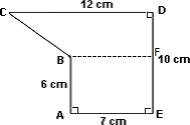
Step: 2
ABFE is a rectangle in which AB = EF = 6 cm and AE = BF = 7 cm. BCDF is a trapezium in which CD = 12 cm, BF = 7 cm and DF = 4 cm as shown.
Step: 3
Area of rectangle ABFE = 7 × 6 = 42 cm2
[Area of a rectangle = length × width.]
Step: 4
Area of trapezoid = ( 1 2
[Area of trapezoid = 1 2 h b b
Step: 5
Total area of the figure = 42 + 38 = 80 cm2
Correct Answer is : 80 cm2
- Complementary, Supplementary, Vertical and adjacent Angles-Gr 7-Solved Examples
- Finding Missing Angles in Polygons-Gr 7-Solved Examples
- Scale Drawings-Gr 7-Solved Examples
- Application Problems involving Scale Drawings-Gr 7-Solved Examples
- Solving Problems on Area of a Circles-Gr 7-Solved Examples
- Circumference of Circles-Gr 7-Solved Examples
Related Worksheet
- Division
